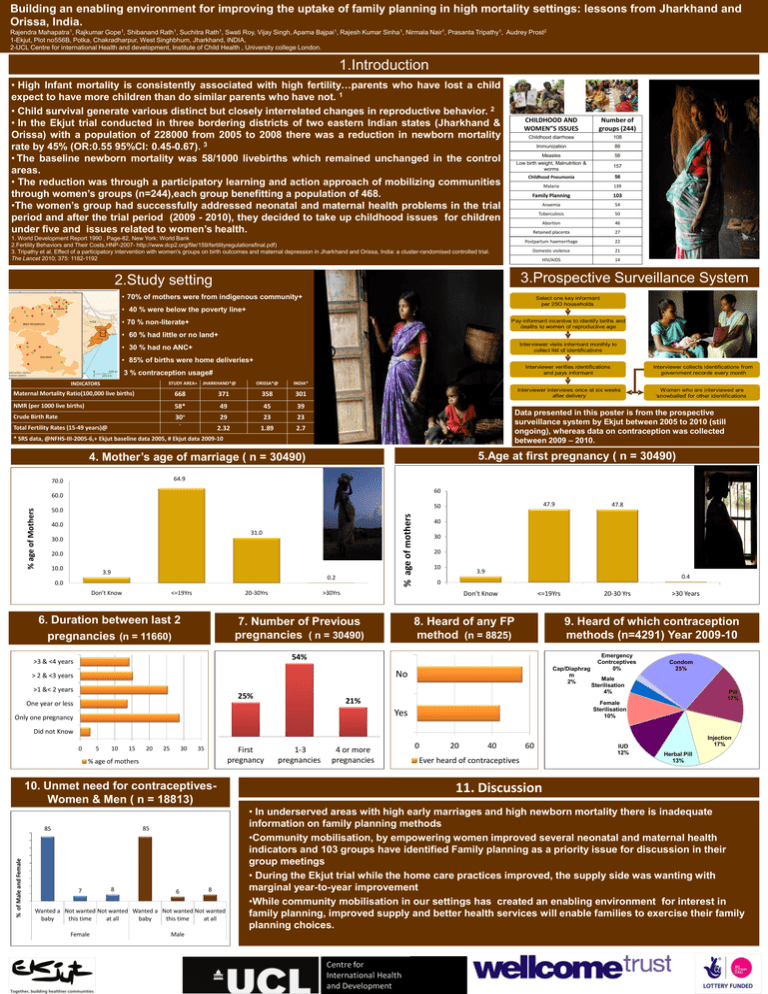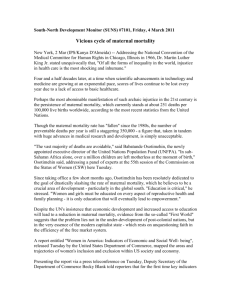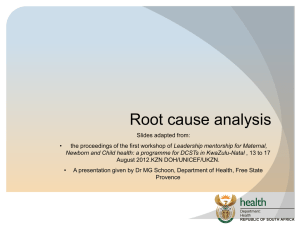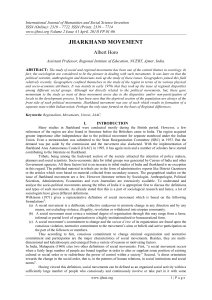Document 13873669
advertisement

Building an enabling environment for improving the uptake of family planning in high mortality settings: lessons from Jharkhand and Orissa, India. Rajendra Mahapatra1, Rajkumar Gope1, Shibanand Rath1, Suchitra Rath1, Swati Roy, Vijay Singh, Aparna Bajpai1, Rajesh Kumar Sinha1, Nirmala Nair1, Prasanta Tripathy1, Audrey Prost2 1-Ekjut, Plot no556B, Potka, Chakradharpur, West Singhbhum, Jharkhand, INDIA, 2-UCL Centre for international Health and development, Institute of Child Health , University college London. 1.Introduction • High Infant mortality is consistently associated with high fertility…parents who have lost a child expect to have more children than do similar parents who have not. 1 • Child survival generate various distinct but closely interrelated changes in reproductive behavior. 2 • In the Ekjut trial conducted in three bordering districts of two eastern Indian states (Jharkhand & Orissa) with a population of 228000 from 2005 to 2008 there was a reduction in newborn mortality rate by 45% (OR:0.55 95%CI: 0.45-0.67). 3 • The baseline newborn mortality was 58/1000 livebirths which remained unchanged in the control areas. • The reduction was through a participatory learning and action approach of mobilizing communities through women’s groups (n=244),each group benefitting a population of 468. •The women’s group had successfully addressed neonatal and maternal health problems in the trial period and after the trial period (2009 - 2010), they decided to take up childhood issues for children under five and issues related to women’s health. CHILDHOOD AND WOMEN”S ISSUES Number of groups (244) Childhood diarrhoea 108 Immunization 86 Measles 56 Low birth weight, Malnutrition & worms 157 Childhood Pneumonia 56 Malaria 139 Family Planning 103 Anaemia 54 Tuberculosis 50 Abortion 46 Retained placenta 27 Postpartum haemorrhage 22 Domestic violence 21 HIV/AIDS 14 1. World Development Report 1990 , Page-82, New York: World Bank 2.Fertility Behaviors and Their Costs,HNP-2007- http://www.dcp2.org/file/159/fertilityregulationsfinal.pdf) 3. Tripathy et al. Effect of a participatory intervention with women's groups on birth outcomes and maternal depression in Jharkhand and Orissa, India: a cluster-randomised controlled trial. The Lancet 2010; 375: 1182-1192 3.Prospective Surveillance System 2.Study setting • 70% of mothers were from indigenous community+ Select one key informant per 25O households • 40 % were below the poverty line+ • 70 % non-literate+ Pay informant incentive to identify births and deaths to women of reproductive age • 60 % had little or no land+ Interviewer visits informant monthly to collect list of identifications • 30 % had no ANC+ • 85% of births were home deliveries+ Interviewer verifies identifications and pays informant 3 % contraception usage# STUDY AREA+ INDICATORS JHARKHAND*@ ORISSA*@ INDIA* Maternal Mortality Ratio(100,000 live births) 668 371 358 301 NMR (per 1000 live births) 58* 49 45 39 Crude Birth Rate 30+ 29 23 23 2.32 1.89 2.7 - Total Fertility Rates (15-49 years)@ Interviewer interviews once at six weeks after delivery Women who are interviewed are ‘snowballed’ for other identifications Data presented in this poster is from the prospective surveillance system by Ekjut between 2005 to 2010 (still ongoing), whereas data on contraception was collected between 2009 – 2010. * SRS data, @NFHS-III-2005-6,+ Ekjut baseline data 2005, # Ekjut data 2009-10 4. Mother’s age of marriage ( n = 30490) 5.Age at first pregnancy ( n = 30490) 64.9 70.0 60 60.0 47.9 50 % age of mothers 50.0 % age of Mothers Interviewer collects identifications from government records every month 40.0 31.0 30.0 20.0 10.0 3.9 0.2 0.0 Don’t Know <=19Yrs 20-30Yrs 6. Duration between last 2 pregnancies (n = 11660) 40 30 20 10 3.9 0.4 0 >30Yrs Don’t Know 7. Number of Previous pregnancies ( n = 30490) 47.8 <=19Yrs 8. Heard of any FP method (n = 8825) 20-30 Yrs 9. Heard of which contraception methods (n=4291) Year 2009-10 54% >3 & <4 years Cap/Diaphrag m 2% No > 2 & <3 years >1 &< 2 years 25% One year or less 21% Emergency Contrceptives 0% Condom 25% Male Sterilisation 4% Pill 17% Female Sterilisation 10% Yes Only one pregnancy >30 Years Did not Know 0 5 10 15 20 25 30 35 First pregnancy % age of mothers 10. Unmet need for contraceptivesWomen & Men ( n = 18813) 85 % of Male and Female 85 7 8 6 8 Wanted a Not wanted Not wanted Wanted a Not wanted Not wanted baby this time at all baby this time at all Female Male 1-3 pregnancies 4 or more pregnancies 0 20 40 60 Ever heard of contraceptives IUD 12% Injection 17% Herbal Pill 13% 11. Discussion • In underserved areas with high early marriages and high newborn mortality there is inadequate information on family planning methods •Community mobilisation, by empowering women improved several neonatal and maternal health indicators and 103 groups have identified Family planning as a priority issue for discussion in their group meetings • During the Ekjut trial while the home care practices improved, the supply side was wanting with marginal year-to-year improvement •While community mobilisation in our settings has created an enabling environment for interest in family planning, improved supply and better health services will enable families to exercise their family planning choices.






